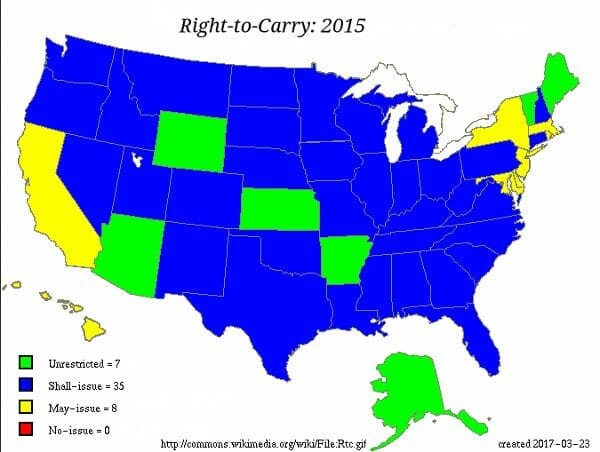Opinion

Arizona -(Ammoland.com)- -A new study of violent crime and concealed carry law found no correlation between them.
The study compared homicide and violent crime at the state level with changes in concealed carry law over a 30 year period, from 1986 to 2015. During this period there were substantial changes in the laws regulating the carry of concealed weapons. From the study:
Results
During the study period, all states moved to adopt some form of concealed-carry legislation, with a trend toward less restrictive legislation. After adjusting for state and year, there was no significant association between shifts from restrictive to nonrestrictive carry legislation on violent crime and public health indicators. Adjusting further for poverty and unemployment did not significantly influence the results.
Conclusions
This study demonstrated no statistically significant association between the liberalization of state level firearm carry legislation over the last 30 years and the rates of homicides or other violent crime. Policy efforts aimed at injury prevention and the reduction of firearm-related violence should likely investigate other targets for potential intervention.
The study was published in the Journal of the American College of Surgeons.
This study confirms what a number of other studies have found: Having more people without criminal records, carrying concealed firearms, does not increase violent crime.
The study examined the levels of homicide and violent crime when states moved from “no carry” to “may carry” to “shall issue” to “unrestricted carry.”
It is a significant finding to be published in a medical journal, as most papers I have read about the subject, in health-related journals, make apparent errors in data selection and the scope of the study.
This study avoids the errors of scope by looking at the data over all the states for a 30 year period. It avoids selection bias by considering all homicides and violent crime, not just those involving guns.
This study only looks at detail down to the state level. The studies were done by Dr. John Lott. Lott looks at data down to the county level, not just the states. Lott examines concealed carry by looking at the number of actual permits issued, not only when the law changed. That level of examination is likely to find subtle differences.
Only a small number of studies claim that homicides or violent crime go up as more people carry concealed weapons legally. They suffer from limited scope and/or data selection bias.
Dr. Lott has debunked studies that claim more guns equal more crimes.
This study differs from studies done by Dr. Lott. It attempts to examine the effect of “unrestricted carry” also known as Constitutional Carry. Dr. Lott’s methods have difficulty with measuring the impact of Constitutional Carry. There are no permit numbers to track with Constitutional Carry.
This paper will be used to counter the claims of studies of limited scope, which suffer from data selection bias.
Limiting data to only “gun deaths” or “gun violence” is a clear data selection bias if prevents any consideration of a weapons substitution effect or deterrence from self-defense cases.
Limiting the scope of research to only one state, or just a few years, allows researchers to pick a state or years that agree with their favored thesis.
Public health journals have generally been willing to publish poorly researched studies if it validates preconceptions that “guns are bad.”
Perhaps public health researchers will read this paper, and see the effect of biased data selection and limited scope in the other studies.
About Dean Weingarten:
Dean Weingarten has been a peace officer, a military officer, was on the University of Wisconsin Pistol Team for four years, and was first certified to teach firearms safety in 1973. He taught the Arizona concealed carry course for fifteen years until the goal of constitutional carry was attained. He has degrees in meteorology and mining engineering, and recently retired from the Department of Defense after a 30-year career in Army Research, Development, Testing, and Evaluation.
